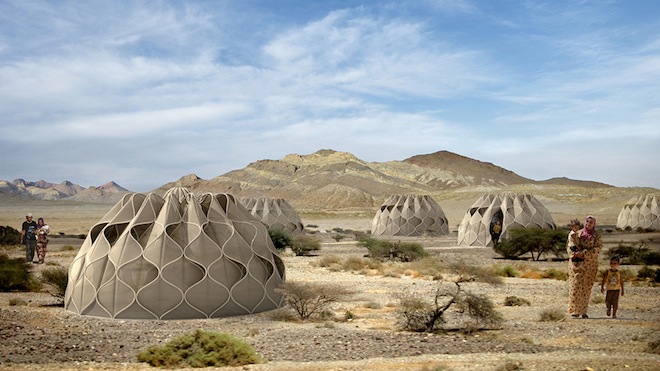 More than 40 million people worldwide have been displaced from their homes and left to find shelter in strange lands. Maybe they find a tarp, or a tent, but their quality of life almost always remains dismal. To close this gap in need, Jordanian-Canadian architect and designer Abeer Seikaly designed a new kind of shelter. One that allows refugees to rebuild their lives with dignity.
More than 40 million people worldwide have been displaced from their homes and left to find shelter in strange lands. Maybe they find a tarp, or a tent, but their quality of life almost always remains dismal. To close this gap in need, Jordanian-Canadian architect and designer Abeer Seikaly designed a new kind of shelter. One that allows refugees to rebuild their lives with dignity.
RELATED: Gorgeous shape-shifting shelters for nomads and refugees that move with the weather
Seikaly, now living in Amman, Jordan is well poised to design a dwelling for refugees given that her ancestors in Jordan probably toggled between nomadic and sheltered life in the desert for centuries.
“The movement of people across the earth led to the discovery of new territories as well as the creation of new communities among strangers forming towns, cities, and nations,” writes Seikaly in her design brief. “Navigating this duality between exploration and settlement, movement and stillness is a fundamental essence of what it means to be human.”
Related: Stackable shelters by Exo
But today, a great deal of migration is no longer voluntary, as wars and climate change force people out of their homes – often with very little money. The collapsible woven shelters, which are conceptual but proven to work, would allow these people to carry their homes with them.
Comprised of a structural woven fabric that “blurs the distinction between structure and fabric,” the shelter expands to create a private enclosure and contracts “for mobility.” It also comes with some fundamental amenities required by modern people, including water and renewable electricity.
Related: IKEA’s flatpack homes for refugees get a reluctant OK from Lebanon
The outer solar-powered skin absorbs solar energy that is then converted into usable electricity, while the inner skin provides pockets for storage – particularly at the lower half of the shelters. And a water storage tank on the top of the tent allows people to take quick showers. Water rises to the storage tank via a thermosiphoning system and a drainage system ensures that the tent is not flooded.
Well ventilated and lit, the shelter opens up in the summer and huddles down during cold winters. But most importantly, it allows refugees to have some semblance of security, some semblance of home.
“This lightweight, mobile, structural fabric could potentially close the gap between need and desire as people metaphorically weave their lives back together, physically weaving their built environment into a place both new and familiar, transient and rooted, private and connected,” says Seikaly.
“In this space, the refugees find a place to pause from their turbulent worlds, a place to weave the tapestry of their new lives. They weave their shelter into home.”

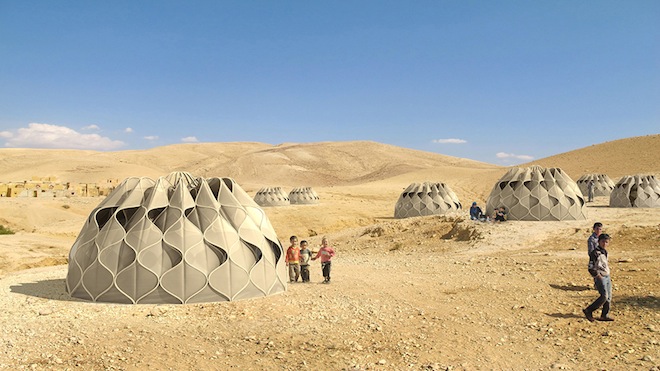
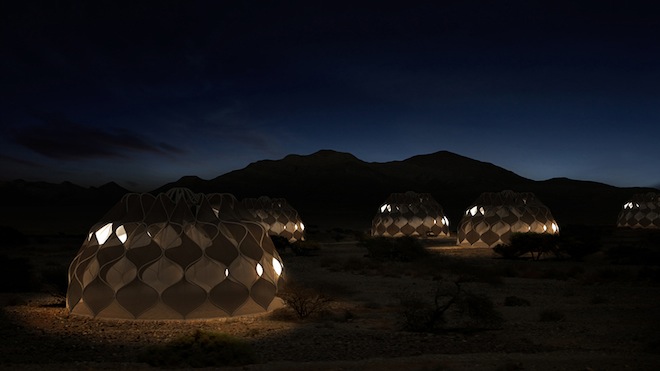
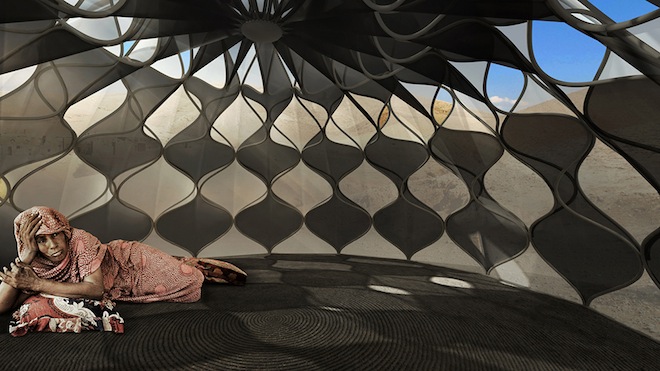



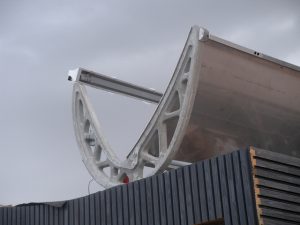
Hi there
where can i buy a Collapsible woven refugee shelters powered by the sun.
kind regards
omar
This is totally amazing, this could help many people specially homeless people in Africa. It’s very comfortable and it is solar powered, you don’t need to pay taxes for waters and electricity.
Quality content is the main to attract the visitors to
go to see the web site, that’s what this web page
is providing.
The stories I saw today were about older RV’s that were completely destroyed by
fire, one was definitely a propane fire and the other is still under investigation. As for outdoors sports,
in summer months you can play in the lake with sports like water skiing,
boating, fishing and fishing. The fact that it stored my good friend secure obtained me convinced that it
would do the same for me.
I don’t understand this article… You should check http://www.redsn0w.us/
for more details
I like this article! Also, check out my RedSnow site
here: http://www.redsn0w.us/
There’s no connection what-so-ever between the article and your site. I’m puzzled why it’s even on the post.
Since an overwhelming number of refugees are living in the Middle East finding sustainable ways to house them IS within our scope.
I applaud this high tech and low tech solution for shelter. I have read many of the comments both positive and negative. Many have listed complaints addressing sanitation or portability. I think that the portability issue does not deserve any merit. In reference to that consider the yurt used in Asian cultures by nomadic peoples. That is a far more complex structure to assemble and cannot be backpacked. This is not a simple camping equipment design. The purpose is of a somewhat more permanent settlement or community. When relocation is desired then truck or pack animals should be able to transport the homes to a new location. Refugee or nomadic status does not mean that a group of people are totally without resources, although in extreme cases I know that condition will exist. The sanitation consideration is also a responsibility of the individual. Toilet facilities and washing of clothing and eating implements are not a part of this design. The community could have common solutions for each of these needs as well as food preparation areas. I know that in many eyes this is not the perfect home but this is a versatile shelter that provides much more than a simple tent.
Put me down for one.
It looks a little biti like we are on planet Mars, but it is functional, and clean.
It is a solution for many homeless people in the world.
why not reconsider Geodesic domes, they are easy to build, very durable and unlike the “woven shelter”, they appear to be much more water and wind resistance and can be built from a variety of different materials including metals, wood or plastic, once provided with the connectors.
Read more about Geodesic domes here:
http://en.wikipedia.org/wiki/Geodesic_dome
Perhaps because the materials you speak of need to be shipped in, cost a lot, and take up a lot of space jun the shipping process. Also, my guess is that this homes go up much faster with less skill needed. Geo domes have their place, as do these.
I find it alarming that so many people miss the idea of these structures. It doesn’t seem to be an all in one “tent” The fact is you’d have a few of these, just like rooms in a “house” fair dinkum I wasn’t first in line when handed out brains but I sure as eggs wasn’t last in line……
So it sucks up sewage from the street and makes the whole structure stink of it?
I am not an engineer but having your water storage & shower over the top of your battery doesn’t seem to make sense? The article says these shelters are portable, but portable is relative. How much does each shelter weigh? How bulky are they? Do they require a truck or can they be transported by people on foot?
Not to mention, carrying a battery on foot, even a small car battery is a bitch to carry.
People in developing countries carry batteries quite a distance. Really not an issue. As for the structure, yeah, I’d like to know what it weighs. Even if it were 100 pounds, and I doubt that very much, 2 people could carry that easily for days. Note:I’ve lived in rural Haiti for 17 years so have some idea of what I speak.
Hi,
Where can one get more information about this product and eventually obtain one for testing in harsh environments? I would like to purchase and test one unit in Norwegian winters if this is possible?
Please e-mail me with further information and a quote, if you have passed the prototype-phase yet and this is actually being produced.
Best regards,
Samuel
This is a very impressive shelter. Not only does it serve as a shelter but, it’s very attractive as well which gives the person/s a sense of pride and dignity. What is the cost of it? Are there larger sizes available? Where can it be purchased?
I’m interested in the cost, sizes and availability of this as well.
Looks too complicated to me. I can see failures with just the basic premise of combining all of these elements within one unit. Simplicity and lightweight is the key to all movable shelters. Water storage on the roof is a terrible idea, if even temporary. Movable water storage is key in just basic camping. You have to set up your shelter before being able to collect water?, yikes. The water on the roof would weigh a ton/can’t move it/have to create the structure strong enough to hold it up(causing a greater overall weight to the structure)/makes it top heavy (horrible for storms). You never clean or wash anything where you sleep, unless you want to get rid of the refugees with disease. The engineer who thought of this should go backpacking once, I can tell by the design they have no idea what living in a tent and moving camp around is actually like. I love the idea of making a better shelter for those that are displaced though. Oh yea, and having your solar collectors fixed to the structure is not the brightest idea either, unless you are in a desert with no shade to put your shelter under in the first place anyway. We have had adequate technology to help these people for decades, we just don’t do it because it is not profitable.
It seems to me that these are meant to provide shelter for people living in refugee camps, where many spend months, years, or even decades, just as the UNHCR tents currently often used are not meant for people on the move, but for people who are going to be in a camp for an extended period of time. Their needs are vastly different from those of someone on a camping trip, and your suggestion that the designer should go on one to get an idea of what a refugee needs is both arrogant and ignorant.
Of the world’s fifty most populous refugee camps, the vast majority are in eastern and central Africa and the Middle East, and any vegetation in and around them is is usually cut down and used for fire wood pretty quickly, most refugee camps are desolate places. Shade is not really an issue – or only insofar as there is not enough of it in most refugee camps.
I’m not an engineer, but it looks as though the water tank is pretty small, and it’s at the apex of a semi-spherical structure, which I would think should be more than strong enough to support a few gallons of water due to its shape, and also that – again because of the shape and the location of the tank – the weight would help anchor the whole tent, rather than make it top-heavy and easy to blow away.
You may have a point re. the water and disease, but I can hardly imagine the designer hasn’t considered this and done something about it.
Great reply. I believe the article did say something about having a quick shower, as in limited water supply. This structure would be so much better than those brought into Haiti a few years ago. I’d like to see a video of one being carried and set up. My guess is that it goes up quickly. If solar panels are a separate item they would be stolen.
Absolutely, there is way too much ‘concept’ in this design and not enough practicality. And different conditions require different kinds of tents. But Seikaly certainly deserves credit for working on this important issue.
I am interested in being updated on who is the really original designer of these structures!
Sorry. Really the original designer.
i assumed that this is copy from my idea , my idea is a research project for my masters degree in U.K. which is inspired again from Nader Khalili works in 2004 and Shigeru Ban.
My researched has been submitted on 2011 to the university of Salford , And to the Jordanian associations of engineers .so i wonder when Mrs. Abeer finished her design .?!! and based on what rules you help to publish her design easily like that ?
waiting your reply
thank you
M.Sc. Arch . Yahya Ibraheem
[email protected]
Can you send us some images please? Of your original idea? To [email protected]
ofcourse ,then what is next ?
check your e_mail please
Plagiarists are everywhere
Then add a LENR or Cold Fusion generator coming soon in America and no more need for hunger starvation or shelter problems for a world free of dirty energy both physically and spiritually.
would like more info when known. Would like to get our Rotary Club involved. Looks superior to the tents we provide in emergency situations. Disaster Aid Canada might really like this concept.
I agree. Rotary could utilize these tents in so many countries. As a missionary in Haiti, and a blessed recipient of Rotarian funds over the years, these structures are so much better then what most projects provided following the quake. NOt so sure that the water collection is important as in camps, water is provided. Seems this structure might only hold a could gallons.
I like! I want one. I am ready to pack my house on my donkey and become nomadic. These blood thirsty multi-national corps are wearing me out.
I would like to have one of these in my backyard in the city but probably some of the neighbors and lots of city officials would have a fit.
If it isn’t square then it just won’t fly in these parts.
So make it square, shower it with concrete and build brick walls into it.
IKEA is also donating $1.00 for every LEDARE led light sold to the UN Refugee project.
I love the idea of having some identity or ownership for people that are struggling to merely survive. Knowing more specifics about size, weight, costs of the shelter, etc., would help bring many ideas to make this product become more available as a reality.
Please let me know where to buy and price. This is a fascinating product.
Where oh where can I buy one?
She can be contacted at: [email protected]
Whatever the price, these only become cost prohibitive when it’s decided the members of our species who would be receiving them aren’t worth it. The world never seems to lack money for wars, corruption, or to line the pockets of those who will never face the ramifications of their decision to squander money on the first two things. So the cost of them, no matter how much or how little, has nothing to do with feasibility and everything to do with the priorities of the human race as a whole. As long as we (meaning the species as a whole) continue to accept war as an acceptable means of conflict resolution and corruption as a generally accepted form of leadership, there will never be the enough funds to insure projects like this reach everyone who needs it. Of course, if those two things ever became unacceptable and we as a species were able to mature beyond that, the there would likely be far less need for these tents.
Since they are needed, I wish there was more information either in this article or on the site of the designer on how to go about helping to fund these.
Audra! You said it so well. So perfectly clear. Brilliant. Beautiful.
My country is spending money on war but not even to care for those who fought in it and certainly not to feed the children in it.
What is the cost of one of these?
How do we stop people who cannot afford to feed themselves from bringing babies into the world which they cannot afford to house or feed?? Why do they insist on bringing more people into their life – which they cannot afford? The rest of us have no obligation to care for these folks who make poor decisions. The world is not obliged to provide shelter or anything else.. This global handout mentality has to stop sometime..
Accountability can be a powerful thing..
I hope you don’t vote for politicians that prevent the funding of International Planned Parenthood or that block insurance companies from covering the prices of birth control…ie. the current Republican party platform. Troubling also are the evangelical religious groups that have gone all over the world and removed the people’s natural way of keeping populations in balance such as native plants etc. Tribal people in so many parts of the world had sustainable populations for thousands of years until we brought our ‘morality’ to them.
But it has actually been shown that as people get better conditions and education, the birthrate goes down. So in answer to your question – education and helping people rise out of poverty is how you stop people from bringing more babies in to the world…
http://www.globalissues.org/article/206/poverty-and-population-growth-lessons-from-our-own-past
http://borgenproject.org/birth-rates-decrease-as-people-rise-out-of-poverty/
Agreed, Jess. It is well researched and documented that education decreases poverty and birthrate.
Tnks 4 your incite. Only through compassion will we change, heal anything.
Accountability is a very interesting word for someone from a place that has probably raped so many other countries of their resources for so many years, imposed fake leaders for so many years, and recently dropped bombs on infrastructure so as to prevent any growth…but i guess your just talking about other people.
Kindness to others will never run out while there are kind people in the world…………give a little you may find you like the good feeling inside ! I trust you never find yourself in a situation that is totally beyond your control, and that kindness flows through you to allow you to have kind thoughts of others…………
What a horrible philosophy MDC. Why do these people have babies? Same reason anyone else does, it is about genetic potential. Any one of ‘those’ people could be carrying the gene that kills the AIDS virus. Any one of ‘them’ could harbor the intellectual capacity of an Einstein.
We owe nothing to ‘those’ people? We owe everything to our people, and everyone IS our people.
Are you inviting to show them how to live better, to flourish better? Are you offering to move them elsewhere to a better suited environment? Are you inviting them to come here and stay with you?
If I understand you correctly you are suggesting we leave them to die because they aren’t worth anything else. Is this your opinion?
If so, please find it in your heart to rethink your position. Increasing your intolerance for anything increases intolerance in the world. Increasing your compassion for anyone, increases the compassion of the world. Let us grow better together.
Peace
Well I am pretty sure that the large multi-national corporations owned by the U.S, Canada, Australia, UK, France, Germany, etc are responsible for stripping many ‘third world’ countries of their natural resources for themselves with minimal payment to locals/country…the same resources that are in all the gadgets and products you buy….are you making the multi-national corporations be accountable for their destruction of countries and communties and robbing the people of their wealth?
And thanks to the majority of countries in Africa having been colonies of the afore mentioned first world countries, which screwed up sooo many things in Africa, yes we do have an obligation to these people! Are first world countries accepting accountability for screwing up Africa? I don’t believe so.
Contraception is not readily available in developing/middle income countries. These countries are not profitable for pharmaceutical companies. NGO’s are the main providers of contraception, and they have limited funds. People in developing countries cannot afford to buy contraception (if it is available), as many dont have cash (as they are subsistance farmers) or prefer to spend what little money they have on things like food. Or it may be a 4 day walk to the nearest town that stocks contraception. And what man do you know that voluntarily says “I’m going to have less sex”? In these societies, a mans’ wife would very rarely say no to sex as that would very likely result in her being beaten, or being kicked out by her husband. In South Sudan, women do not have sex for two years after giving birth, in order to give the child and the mother the best health. But this is also why men in Sudan have more than one wife…….how do you change thousands of years of ingrained cultural norms? As Jess says, the more general education (eg primary education, secondary education) a woman has, the less children she has.
The major contributor to the environmental down fall of the planet is the Earth being over populated. People in ‘western’ countries eating way too much and throwing out the rest (that carrot isn’t straight enough) and feeding grain to cows instead of starving people.
In order to stop the destruction of the Earth I propose that every human on earth is only allowed to have ONE child each, including you MDC. Or are you not accountable for your part in the destruction of the environment? Is it only other people that have to be accountable?
MDC,
In many parts of the Global South there are cultures where one’s status is still based on the size of one’s family, especially having sons. So often times the only thing that women find their worth in is bearing children. Blame patriarchal societies.
It is a known fact within Development that when women are educated (even just learning to read) and empowered (through a cottage industry for example) they learn the value of smaller families and will even secretly take advantage of birth control methods made available through the local NGO. Even when the U.S. is compared to Sweden, this theory holds water. The more educated a society is, the smaller the families are.
But you see, it is often the men who enforce antiquated cultural norms at the expense of their own hungry children, but they just don’t understand the connection. And because it is still believed that gods (not sperm) create children, sex ed is a big part of the solution; however, an even larger hurdle is creating the paradigm shift among those in power and undoing GENERATIONS of cultural expectations.
So how can we help? Check out organizations like Kiva.org, or support the Gulabi Gang.
“To educate a girl is to reduce poverty”-Kofi Annan
“When men are oppressed it’s a tragedy. When women are oppressed it’s tradition.” -Letty Cottin Pogrebin.
Peace,
Kelly
MDC – Your statement reveals a very cold, and incredibly self righteous perspective. I don’t even want to explain to you why your view of the world and its struggling people promotes even more heartache. I think you should volunteer somewhere on the planet – somewhere other than the cozy safe suburb you obviously live in. But before you leave on your journey, it would be helpful to memorize the definition of the word “humanity”, just to prepare yourself for the wondrous adventure you are likely to experience.
Lily,
MDC’s response is not as cold as it is just plain ignorant. The same ignorance that causes humanity’s suffering is only perpetuated by the uneducated opinions that are much like MDC’s. With our help, MDC can begin to experience a new perspective. Those who work in Development come up against this type of closed-minded, isolationist attitude daily, especially in the West. COMPASSION and CULTURAL COMPETENCE, and οἰκτείρω, are quite lacking where people are obsessed with capitalism and greed so we have to be patient and plant seeds of kindness and love with everyone we meet…on behalf of the “people who cannot afford to feed themselves.”
-kelly
These look absolutely brilliant!
We run a small non-profit. One of our goals is to help the homeless in New Hampshire, USA. We’ve been looking for something more durable than a simple tent and more portable then a Hexiyurt. The article mentions that these can be used in both hot and cold climates and from the photos they seem to be quite spacious, able to hold an entire family.
We’d appreciate more information on cost and availability.
and this family will have to move all their stuff so one member can stand on the battery and take a shower in the middle of the room? This is a design project gone awry.
Yes I agree the shower design in the middle of the hut is a silly idea…..water storage is a great idea. But considering in many refugee camps there is minimal water supply, people use their allocated water for cooking and drinking not for showering.
Why not contact the One organization for starters to look into funding? Good jumping off point.
This looks fascinating , I would like more information on when this would be available . I see the usefulness is expansive .
Here in Australia, we use the navy to transport refugees to prisons offshore that we built on former British colonial islands. We spend $900 per refugee per 24 hours to keep them in these prisons. The prison guards are housed in floating hotels. When there is a riot or the prisons are invaded by angry local people wielding clubs and machetes, we have an inquiry. The inquiry costs a million dollars and it finds that it wasn’t our fault.
Very noble idea Frank, until your health, education and house ing cannot cope with the influx of people with no right to enter Australia.
Actually, every single person in the world has the right to enter Australia as an asylum seeker. I believe Frank is saying that the money spent on keeping asylum seekers in detention centers (about $200000 per person per year) and on the inquiry, could be better spent (it costs only $35000 to house an asylum seeker in the community). And the Australian government doesn’t let Asylum seekers work to earn their own money so they are dependent on handouts from the government (included in the $35000). When Asulym seekers were living in the community, they had no access to the public health care system or education. They relied on not-for-profits providing it for them. And the number of people entering Australia as asylum seekers or refugees is tiny compared to the number of economic migrants let into Australia, and tiny compared to how many asylum seekers or refugees are recieved by other countries as a percentage of GDP.
That is very enlightening information. I guess for some people it’s better just to hate rather than get facts. We have the same in the US about the budget.
A couple of notes that may clear some things up:
1.) Based on Abeer’s website, finances may not be a problem.
2.) Also based on Abeer’s website, whoever wrote this article did not look much at that website: the article keeps using the male pronoun, and Abeer is a woman (see http://www.abeerseikaly.com/about.php .)
Contact information is also available on that website should anyone want to contact her
Thanks. We’ve updated the he to a she.
Abeer is indeed a woman. She is Canadian-Jordanian and she lives in Amman, Jordan. It’s settled. I’ve spoken with her.
I know campers who would love one of these. Selling them could help with funding. There is no link to Kickstarter or Crowdfunding sites. How can we help?
I agree, Private sales could help with funding . . .,I too would LOVE ONE !
This would be an interesting endeavor, especially if the growth and use of Kenaf was included. Kenaf is a great carbon sequestration resource that produces a food and fabric resource. One acre of Kenaf results in 10 tons of carbon sequestration per growing season and approx. 5 dry tons of biomass upon harvesting… @$55/ton market value.
Did I miss where it says how much each costs? Or how we can help with donations? It’s great idea (aside from taking a shower in the middle of your living quarters and getting the whole place wet, but at least there would be privacy to do so). What’s the next step to get these to the people who need them… Anyone know Pitt or Clooney?
I remember way back a relief worker saying all these designs are fine but what we need are tents.
Middle class festifarians can buy and pay for one to be donated to refugees.
HOW ?
Mongolia has had somethiing like these for years, minus the solar panels.
Are you speaking about yurts?
They are practical and look good. Love this idea.
Would like to build one on the beach. Tell me more about durability, and rain and wind resistance
Very innovative and provoking. It can be appropriate for tropical and moderate climates facing severe shelter shortage.
When you can produce this at a price of £20.00, let me know, and I’ll buy one. P.S. I live on pension credit in the U.K. And if I can’t afford one, neither can any other refugee.
That was just my thought too Tony. Guess we Brits are still rational / miserable buggers at heart. Get a feeling these are only ever going to get used by middle class wanna be kids to go to middle class festivals, and not for nomadic peoples as refugee shelters.
What’s really nice about these dwellings is that they honor some of the age-old design and practical needs of people who are either nomadic or villagers, rather than forcing Western technology on them in the form of cement rectangular dwellings, hot in summer/cold in winter with unsustainable sources for heat and cooling. Architect Nader Khalili who founded Cal Earth Institute in Hesperia CA wrote of the technocratic insensitivity with which traumatized peoples are met. Amazing design…I would like to buy one (or more) of these!
If they can be produced for less than IKEA’s $7500 a piece Flat-Pack homes (see link), then there’s a chance they will be useful for aid organisations – unless the fabric/technology blows out the price, they should definitely weigh less than metal-panel constructions…
http://www.greenprophet.com/2013/12/ikeas-flatpack-refugee-homes-lebanon/
Just a small note: Abeer Seikaly is a female Jordanian/Canadian architect and designer.
Issues like weight, cost and production are most challenging and I’m looking forward to seeing the development of this wonderful and impressive project.
Just a small note: Abeer Seikaly is a female Jordanian/Canadian architect and designer.
Issues like weight, cost and production are challenging and I’m curious to see the development and direction of such a wonderful and impressive project.
Looks very nice but it feels like the cost of making and delivering it will be prohibitive. Keep trying.
I wonder what these would weigh…. I’d like one to take to Bluegrass Festivals, etc…..
I agree Chris – these would be ideal for any kind of festival! I’ll try to find out how much they would weigh…
I agree that – unless the designer gets a major grant or a contract with a major aid organization – this wouldn’t be feasible for most refugees.
What a great idea although how much would this cost. If it’s cost prohibitive, no matter how well it may work it is not feasible for the host country/donors to purchase it. Unless it would be a permanent structure which foils the original use of the structure. Love the idea, it’s fabulous, but how realistic is this?
This is pretty exciting, but is this thing in use? Wouldn’t it be great to be able to give these things to people to own? So they would have something they could call theirs? So are thses in production?